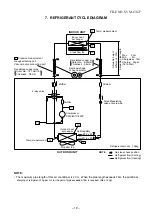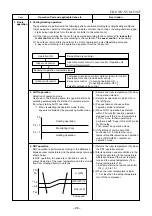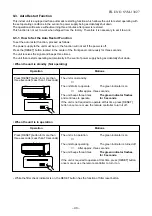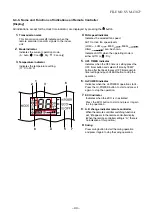
– 31 –
Item
6. Release protective
control by tempera-
ture of indoor heat
exchanger
Operation flow and applicable data, etc.
<In cooling/dry operation>
(Prevent-freezing control for indoor heat exchanger)
In cooling/dry operation, the sensor of indoor heat
exchanger detects evaporation temperature and
controls the compressor speed so that temperature of
the heat exchanger does not exceed the specified
value.
Description
1) When temperature of the indoor
heat exchanger drops below 5°C,
the compressor speed is
reduced. (P zone)
2) When temperature of the indoor
heat exchanger rises in the
range from 6°C to under 7°C, the
compressor speed is kept.
(Q zone)
3) When temperature of the indoor
heat exchanger rises to 7°C or
higher, the capacity control
operation returns to the usual
control in cooling operation.
(R zone)
1) When temperature of the indoor
heat exchanger rises in the
range from 52°C to 55°C, the
compressor speed is kept.
(Q zone)
When temperature of the indoor
heat exchanger drops in the
range from 48°C to under 55°C,
the compressor speed is kept.
(Q zone)
2) When temperature of the indoor
heat exchanger rises to 55°C or
higher, the compressor speed is
reduced. (P zone)
3) When temperature of the indoor
heat exchanger does not rise to
52°C, or when it drops below to
48°C, the capacity control
operation returns to the usual
control in heating operation.
(R zone)
<In heating operation>
(Prevent-overpressure control for refrigerating cycle)
In heating operation, the sensor of indoor heat ex-
changer detects condensation temperature and controls
the compressor speed so that temperature of the heat
exchanger does not exceed the specified value.
7˚C
6˚C
5˚C
R
Q
P
55˚C
52˚C
48˚C
P
Q
R
Usual cooling capacity control
Reduction of compressor speed
Indoor heat e
xchanger temper
ature
When the value is
in Q zone, the
compressor speed
is kept.
Reduction of compressor speed
Usual heating capacity control
Indoor heat e
xchanger temper
ature
When the value is
in Q zone, the
compressor speed
is kept.
FILE NO. SVM-13027
















































